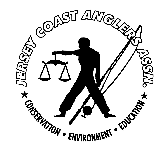 |
 |
|
|
||
Hudson River PCBs To Be Removed
by Chas Stamm
(from Jersey Coast Anglers Association September 2001 Newsletter)
Shortly after word came through the
news wire on the morning of August 1, 2001, lawsuits were being filed. Federal EPA Administrator Christie Whitman issued
a statement supporting the Record of Decision that her agency had issued in December of
2000. That record of decision stated that…
after examining all the science, after looking at all the evidence, after considering all
the concerns of the citizens, after the testing was done by EPA and independent facilities
as well as the General Electric Company, and after a public comment period where over
70,000 faxes, e-mails and letters were written, Yes…the best solution and remedy for
cleaning up the Hudson was to remove the toxic PCBs from the sediments. These toxins are not staying in place as GE
claims. These toxins are not harmless as GE claims. The PCBs are not just in the sediments
but in the water column as well. And…
Now in 2001, we do have the technology to remove these PCBs without re-suspending them
into the water column. To ensure this, monitoring every stage of this project will be
done.
This EPA ruling came as a great
message to all who supported a cleanup of the Hudson River.
The Jersey Coast Anglers Association and its member clubs are is in full
agreement with the EPA. Sometimes in the past
we are at odds with the EPA. Not on this one. This time they did their homework. New Jersey Chapter of the Hudson River Fishermen’s
Association has been one of the clubs taken a lead in this battle.
When first studied in 1984 the EPA
recommended dredging not be done. At that time, the style of shoreline-to-shoreline
dredging would have stirred up the bottom and created more of a problem. The HRFA NJ agreed… it would have made things
worse. However, they did leave the issue open for future review.
Dredging techniques have improved in
the last 15 years…they have developed newer, environmentally safe dredging methods
that can do the job safely. This latest study by the EPA took over 12 years to render a
conclusion. We applaud their decision. But…it’s
not over.
As
state and federal agencies were busy reviewing the U.S. Environmental Protection Agency's
proposal for dredging the Upper Hudson River on Thursday, August 2, 2001, opponents to the
project began to mount a defense almost immediately.
At
a meeting at the Fort Edward firehouse, about 75 supporters of the anti-dredging group
CEASE – (formed in the late 1970s in opposition to a dredging project proposed by the
state) -- sketched a blueprint of where the battle over the Hudson could go next. Among
the suggestions made at the meeting was a lawsuit that would throw a wrench into the EPA
process and drag out a possible 2004 start date for years.
These objections are from the same
towns that allowed the dumping of toxins
into the Hudson in the first place. The shortsighted town officials...got their
jobs, got their tax revenues, and allowed these toxic discharges to go on.
In1977, GE closed its two factories and took with it 1200 jobs from the towns of Fort
Edward and Hudson Falls.
These towns are now left with empty
buildings on toxic waste sites. The buildings are vacant and can't be used for another
thousand years. Acres and acres of PCBs are
being found throughout the properties of these factories.
GE donated many thousands of yards of contaminated soil for use by property
owners, playgrounds and schools. The jobs are gone, the taxes are no longer collected and
the property values of Fort Edward and Hudson Falls have plummeted. The first two lawsuits against G.E due to health
related problems from exposure to PCBs have been filed. Hundreds more are to follow.
Still, a few vocal citizens of these
upstate communities align themselves with the company that ruined their towns in the first
place. Instead of fighting this cleanup program, they should be looking for restitution
from their town officials who allowed this atrocity to happen in the first place. These
factories were built with huge discharge pipes going right into the river. Even in 1947, this never should have been allowed
by code.
These towns have legitimate concerns
about the disruption of their lives due to the dredging that will take place. Eleven NY State communities take their drinking
water from the Hudson. What happens to them when these PCBs get stirred up?
The plan proposed by the EPA shown to
the HRFA NJ addresses all these concerns.
Many letters, which have shown up in
articles, have asked for the federal government to reimburse these communities for the
disruption. We feel this expense should also
be borne by G.E. This disruption still stems
from their illegal dumping.
What troubles the JCAA and it member
clubs is if General Electric is allowed to participate in the cleanup in any way other
than financially. They would like nothing
better than to see this project fail. They
have spent a lot of money to delay and avoid this cleanup.
This avoidance has gone on for almost 30 years. If G.E. is involved in the dredging operation in
any capacity...expect problems. If this
project fails, it will relate favorably for their accountability to the other superfund
sites...for which they are also responsible.
This decision sends several messages. One to GE. Another to all other polluters. Another
about Christie Whitman. Let’s see how
this all pans out and hope we get cleaner water and toxin free fish in the second largest
spawning estuary on the East Coast.
This project, this statement, goes well beyond the Hudson River.